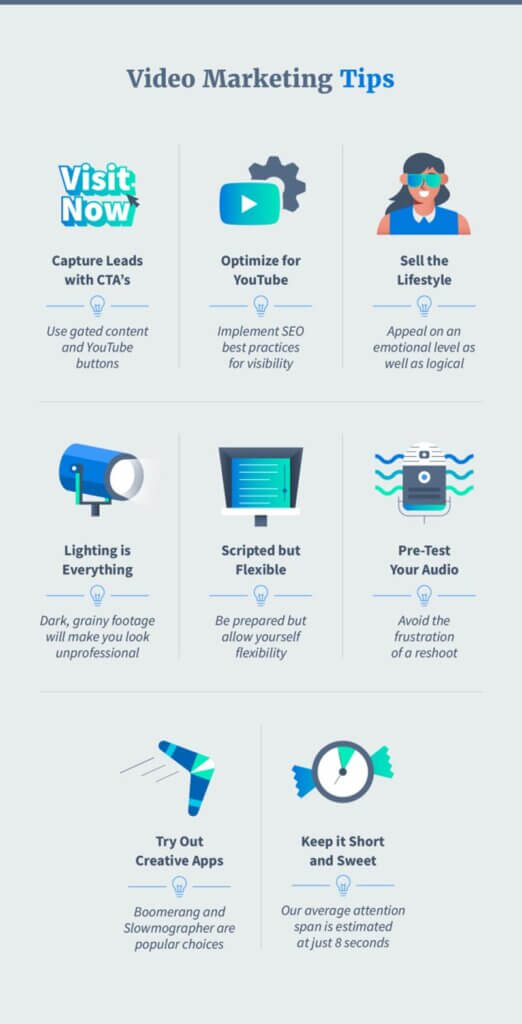
As the world continues to adjust to the evolving COVID-19 pandemic, we are increasingly subjected to an unfamiliar digital reality. Being confined to working from home can make professional development difficult, especially for those who have worked so hard to build a brand for themselves in their industry.
However, remote work is not without its silver linings. For those developing their presence in the professional world, video marketing is proving to be one of the most useful tools for brand development. In fact, according to data from Wyzowl, around 87% of businesses that add video marketing into their digital campaigns see significant increases in site traffic as a result.
With many layouts and tools available, video marketing is a technologically diverse practice. But it can be challenging to get started when developing a campaign. The following guide explains how to make your journey into the world of video marketing as efficient and effective as possible.
6 Ways to Format a Video Marketing Campaign
The first and most important step of any video marketing strategy is deciding on a format. RentSpree highlights six formatting options that can you can either use individually or combine to improve the quality of a campaign:
- Testimonials: Asking a satisfied customer or client about their experience working with you. This format allows you to show positive reviews of your work in comparison to your competitors.
- “Unboxing” (or “product demo”): Showcasing a product or service you would offer to potential clients. Product demos are simple and are commonly used for marketing in the tech industry.
- Personal Advice: Answering regularly asked questions in a way that is real and develops a more personal connection between yourself and the customer.
- Interview with an Expert: An extended discussion with somebody else within your field about relevant information and new developments in your industry. This format can help market your brand as ahead-of-the-curve and boost your strategy’s success.
- Live Streaming: Use services such as Instagram, Facebook Live or YouTube. This gives potential customers a chance to digitally follow along and take part in important events associated with your brand. Much like the personal advice format, live streams are a good way to develop more personal interactions with your audience.
- Educational: Informational videos that offer detailed explanations of certain topics or challenges clients may be facing. For instance, brands associated with software development could produce content that offers solutions to common problems users have with a certain program on their computers.
Pros and Cons of Professional vs. Amateur Quality Content
After deciding on a format for your marketing campaign, you’re ready to start producing videos! The first and most important step to actually creating your content is to determine the type of video you want to make. Decide whether it makes more sense to hire a team that creates video content professionally or for you to produce the content yourself. So which option is best for you?
Hiring professionals can yield more high-quality content, but they are typically far more expensive than doing it on your own. Producing videos yourself offers more creative freedom at a lower price. Though it usually takes more time for an amateur videographer to fully realize their vision. It’s important to make whatever choice best fits your schedule, budget, and vision for your brand.
How to Extend the Reach of Your Campaign
Any successful video marketing strategist must know how to generate as much online engagement with their content as possible. Creating great videos is important, but their impact will be small if you don’t know how to get the word out. With online platforms expanding daily due to the rise of social media and remote work settings, your options are limitless!
Social and Email Opportunities
The most obvious place to start publishing your content would be your brand’s website. This is where you can make the most out of any video content that demonstrates the most positive aspects of your brand. This includes customer reviews and expert interviews. If your brand deals with technology, adorning your “About” and “Blog” sections with personalized educational videos and product demonstrations can generate optimal traffic to your website.
Once you’ve got your website set up, now it’s time to move on to social media. This is where live streaming will come in handy in connecting with your clientele. Just about every major social media platform now has a live streaming feature (Facebook Live, Instagram Live, Twitch, etc.). Plus, you can share your shorter-form content such as testimonials. You can also highlight the most helpful and easily digestible moments of longer videos.
For an even more personal touch, you can employ your video marketing content in an email campaign. Networking is one of the most important aspects of marketing. This is because every name on that contact list could lead to a valuable connection for your brand and attract potential new clients.
All in all, video marketing can be a pretty daunting way of developing your brand, but it’s an important tactic of the modern professional world. If you make use of the video formats and tactics we’ve described here, you’ll be well on your way to a successful brand strategy in no time. For a more detailed guide on the ins and outs of video marketing, check out the infographic below from RentSpree with more tips.


